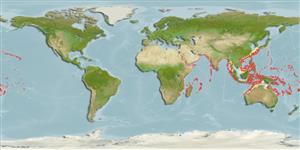>
Eupercaria/misc (Various families in series Eupercaria) >
Lutjanidae (Snappers) > Etelinae
Etymology: Etelis: Greek, etelis, -idos = a fish, perhaps the fish Sparus aurata (Ref. 45335).
More on author: Cuvier.
Environment: milieu / climate zone / пределы глубины / distribution range
экология
морской донно-пелагический; пределы глубины 90 - 400 m (Ref. 9821), usually 200 - 350 m (Ref. 82366). Tropical; 34°N - 25°S, 35°E - 150°W (Ref. 55)
Indo-Pacific: East Africa to the Hawaiian Islands, north to southern Japan, south to Australia. Recorded in Three Kings Island, New Zealand (Ref. 35942). This name has been wrongly used for Etelis coruscans by some previous authors.
Length at first maturity / Size / Вес / Возраст
половая зрелость: Lm 61.0 range ? - ? cm
Max length : 127 cm FL самец/пол неопределен; (Ref. 2016); common length : 65.0 cm TL самец/пол неопределен; (Ref. 5450); наибольший возраст (опубликованны данные): 32 годы (Ref. 92312)
колючие лучи спинного плавника (общее число) : 10; членистые (мягкие) лучи спинного плавника (общее число) : 11; колючие лучи анального плавника: 3; членистые (мягкие) лучи анального плавника: 8. This species is distinguished by having the following characters: body relatively elongate, laterally compressed. Nostrils on each side of snout close together; lower jaw protruding slightly; premaxillae protrusible and maxilla extending to below middle of eye; both upper and lower jaws with conical teeth; 1 to several enlarged canines on each side of both jaws; vomer and palatines with teeth, those on vomer in a chevron-shaped patch; maxilla with scales,
but without longitudinal ridges. Interorbital region flattened; gill rakers of first gill arch 5-8 + 11-14 = 17-22 (including rudiments; dorsal fin continuous, but spinous portion of fin deeply incised at its junction with soft portion; last soft ray of both dorsal and anal fins produced, longer than next to last ray; caudal fin forked, the lobes relatively short (about 25-30% SL) compared with its congeners; pectoral fins fairly long (in specimens > 19 cm SL), length of pectoral fins about 80-90% of head length, with 15-17 rays; membranes of dorsal and anal fins without scales; tubed lateral-line scales 48-50. Colour: mainly pink to red, becoming white on lower sides and belly (Rfe. 9821).
Body shape (shape guide): fusiform / normal; Cross section: oval.
Adults inhabit rocky bottoms (Ref. 30573). Benthopelagic (Ref. 58302). Feed on fishes and larger invertebrates such as squids, shrimps and crabs; also takes planktonic organisms, including pelagic urochordates. An important food fish in some areas. Marketed fresh or frozen (Ref. 55).
Allen, G.R., 1985. FAO Species Catalogue. Vol. 6. Snappers of the world. An annotated and illustrated catalogue of lutjanid species known to date. FAO Fish. Synop. 125(6):208 p. Rome: FAO. (Ref. 55)
Статус Красного Списка МСОП (Ref. 130435: Version 2025-1)
Угроза для людей
Harmless
Использование человеком
рыболовство: важный объект промысла; объект спортивного рыболовства: да
дополнительная информация
инструменты
Специальные отчеты
Скачать в формате XML
ресурсы в Интернет
Estimates based on models
Preferred temperature (ссылка
123201): 13.3 - 23.1, mean 18 °C (based on 290 cells).
Phylogenetic diversity index (ссылка
82804): PD
50 = 0.5312 [Uniqueness, from 0.5 = low to 2.0 = high].
Bayesian length-weight: a=0.01585 (0.01278 - 0.01966), b=2.95 (2.89 - 3.01), in cm total length, based on LWR estimates for this species (Ref.
93245).
Trophic level (ссылка
69278): 4.5 ±0.8 se; based on diet studies.
устойчивость к внешним воздействиям (ссылка
120179): очень низкий, минимальное время удвоения популяции более 14 лет (K=0.07-0.31; tmax=35).
Fishing Vulnerability (Ref.
59153): High to very high vulnerability (67 of 100).
🛈
Nutrients (Ref.
124155): Calcium = 44.5 [17.0, 103.8] mg/100g; Iron = 0.766 [0.383, 1.419] mg/100g; Protein = 18 [16, 20] %; Omega3 = 0.252 [0.142, 0.453] g/100g; Selenium = 106 [54, 230] μg/100g; VitaminA = 24.6 [7.7, 86.8] μg/100g; Zinc = 0.629 [0.408, 0.953] mg/100g (wet weight);
